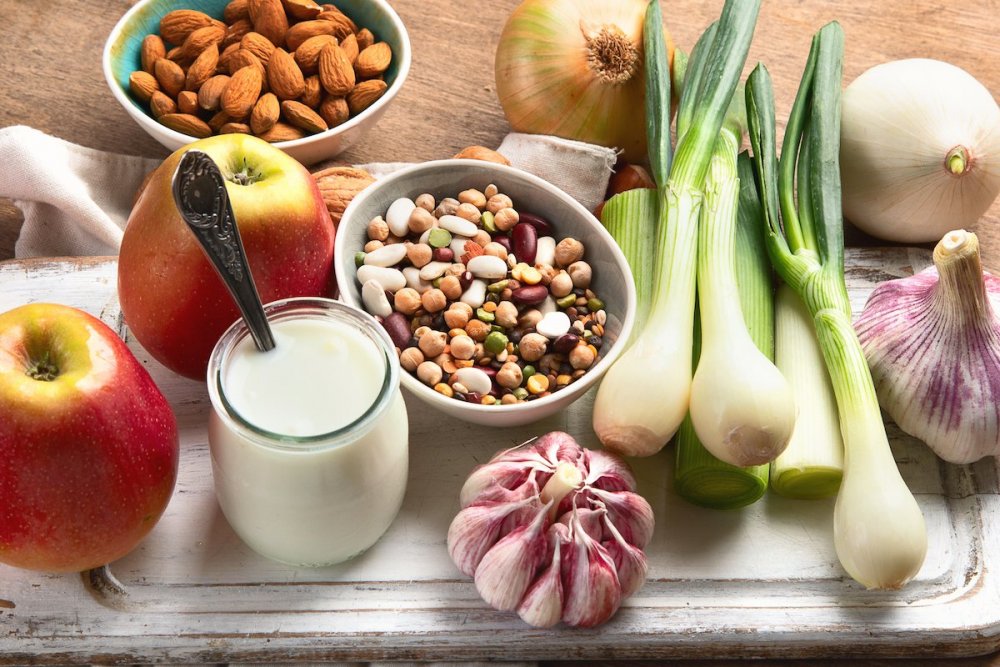We've all heard of probiotics, but what about prebiotics? Journalist and nutritionist Allison Clark explains the benefits of these food molecules to our health. Plus, she outlines 15 of the best prebiotics to add to your diet to aid digestion.
The importance of maintaining a healthy gut microbiome has been gaining more attention. The gut microbiome contains trillions of microorganisms, most of which are bacteria, and plays a major role in various aspects of our health.
Probiotics and fibre have gotten a lot of fanfare lately when it comes to gut health, but in order to feed the “good bugs” or beneficial bacteria in our intestines, we also need to eat adequate prebiotics.
Unlike probiotics, prebiotics are not live microorganisms, and although most prebiotics are different types of fibre, not all prebiotics are fibre. So, what are they exactly and what are the best prebiotics you can consume?
The benefits of prebiotics
Prebiotics are defined as substrates that are selectively used by the gut microbiota that produce a health benefit for the host (i.e. us humans!). Substrates are molecules that enzymes act upon and can include indigestible fibre, polyphenols and polyunsaturated fatty acids.
So, in essence, prebiotics serve as food for beneficial microbes in our guts that result in the production of beneficial metabolites. These have anti-inflammatory and anti-cancer properties for humans, alongside other health benefits.
“Foods that contain high levels of polyphenols act as some of the best prebiotics. They include dark chocolate, green tea, red wine and berries.”
According to UK researcher Glenn R. Gibson (who introduced the term prebiotics to the scientific world), “prebiotics are safe, efficacious and user-friendly. They can also be used prophylactically [and] as an adjunct to existing therapy.” Indeed, some of the proven health benefits of regularly consuming prebiotics include:
- Improved immune health and reduced inflammation
- Reduction in diarrhea and constipation
- Reduced risk of allergies
- Improved mineral absorption
- Improved metabolic health (insulin resistance, blood lipid levels)
- Increased satiety
- Protective effects against cardiovascular disease and colon cancer as well as irritable bowel syndrome (IBS) and Crohn’s disease.
A low consumption of prebiotics may be detrimental to human gut health, resulting in a lower production of short chain fatty acids, increased intestinal permeability and increased pathogen infection.

Apples, garlic, chicory: all important prebiotic foods
Common prebiotic fibres include: inulin, human milk oligosaccharides found naturally in breast milk, galato-oligosaccharides (GOS), and fructo-olgiosaccharides (FOS). Luckily, prebiotics are found in a variety of foods. So, which are the best for you to consume?
The 15 best prebiotics
We can split the most beneficial prebiotics into four main food groups: vegetables, fruits, legumes/grains and seeds. Try to add some from each group into your diet – eat them on a regular basis and you should start to feel the benefits.
Vegetables
1. Onions
A staple vegetable and cheap to buy, onions are rich in the polyphenol quercetin and contain about 10 per cent inulin fibre by weight. They also contain the prebiotics fructan and FOS. These have both been shown to increase the amounts of beneficial bacteria and the short chain fatty acid butyrate production in the intestines.
2. Leeks
Leeks, like onions, also belong to the Allium family and they contain up to 16 per cent inulin fibre by weight. Leeks are also high in the antioxidant kaempferol which has anti-cancer, anti inflammatory and antimicrobial properties. Furthermore, they’re also rich in vitamins B6, C and K, as well as folate and manganese.
3. Garlic
A tasty condiment that has antimicrobial effects, garlic is one of the best prebiotics you can add to your diet. It contains inulin and FOS and has been found to stimulate the growth of beneficial Bifidobacteria and may reduce gastrointestinal disease. Eating garlic in its raw state has even more health benefits for your immune and digestive systems.
4. Jerusalem artichokes
Although their name is deceiving, this tuber vegetable is actually related to sunflowers and not globe artichokes. Jerusalem artichokes are high in inulin which feeds beneficial bacteria and can be eaten cooked or raw.
RELATED: The gut-brain axis
5. Chicory root
Chicory root is one of the richest sources of the prebiotic inulin and is often used as a caffeine-free coffee replacement. Chicory can decrease constipation, increase beneficial bifidobacteria and improve gut function. Incredibly, it contains almost 65 per cent of fibre by weight, making it one of the best prebiotics you can consume.
“A tasty condiment that has antimicrobial effects, garlic is one of the best prebiotics you can add to your diet. Eating it raw has even more health benefits for your immune and digestive systems.”
6. Asparagus
Asparagus is rich in antioxidants and fibre, especially inulin. Furthermore, the polysaccharides found in asparagus may be protective against liver cancer. Its prebiotic benefits are more potent when eaten raw.
Fruits
7. Bananas
Bananas are rich in carbohydrates, vitamins and minerals. Consuming bananas has been shown to increase beneficial bifidobacteria in the gut. In fact, eating unripe green bananas may confer even more benefits as they contain high amounts of resistant starch, which exerts prebiotic effects, and may also reduce insulin resistance.
8. Apples
Apples are high in antioxidants, vitamins A, C, E, folate, and potassium as well as the fibre pectin. The fibre in apples along with their phenol content – which have prebiotic effects on the gut – can improve digestion and lipid metabolism. For the most nutritional benefit, be sure to eat the peel where the antioxidant content is the highest.
Compared to conventionally grown apples, organic apples have been found to harbor less pathogenic bacteria and more beneficial bacteria like Lactobacilli, offering additional probiotics. So, skip the apple juice and eat the whole fruit for the best prebiotic benefits.
Legumes and grains
9. Chickpeas
Chickpeas, like other legumes such as lentils and beans, contain various types of prebiotic fibres, including FOS, GOS and fructans. GOS consumption can lead to increased bifidobacteria levels in the gut, whereas fructans have been shown to increase lactic acid bacteria. To enjoy their prebiotic benefits, chickpeas can be eaten boiled, canned or used as a flour in baked goods.
RELATED: How to heal your gut
10. Wheat bran
Wheat bran is the hard outer layer of the wheat kernel and is high not only in fibre but also starch, protein, vitamins, and minerals. It’s a major source of cereal fibre intake in Western countries and one of the best prebiotics because it contains arabinoxylan-oligosaccharides. These exert a pronounced prebiotic effect that can improve stools and transit, lead to a healthy gut environment, and increase the amount of beneficial bacteria as well as short chain fatty acid production in the gut.
11. Oats
Oats contain one of the best prebiotics studied called beta-glucan. Of all the types of oats, oat bran has the highest fibre and beta-glucan content. The prebiotics in oats have been shown to increase beneficial bifidobacteria species in the gut, which can also reduce plasma cholesterol concentrations.
Consuming oatmeal porridge has also been shown to improve the gut microbiota composition. The beta-glucan found in oats also have anticancer properties and may improve blood sugar.
12. Barley
Barley, like oats and wheat, contains the prebiotic beta-glucan and can also lower blood sugar. Additionally, studies have shown that barley can increase short chain fatty acid production in the gut and can significantly change the gut microbiota composition, such as increasing Lactobacillus strains in the gut. Beta-glucans found in barley have also been shown to reduce total and LDL cholesterol.
Seeds
13. Flaxseeds
Flaxseeds are rich in fiber, the omega 3 fatty acid alpha linoleic acid (ALA), lignans and antioxidants that promote regular bowel movements and regulate blood sugar. One study showed that the gut microbiota fermented the flaxseed fibre into short chain fatty acids which were protective against obesity.
Due to its high omega 3 content, it’s best to eat flaxseeds raw so that cooking doesn’t oxidize the fatty acids. Lignans may prevent certain cancers, especially hormone-related cancers, as they’ve been found to regulate estrogen levels.

Apples contain powerful prebiotics shutterstock/ShotPrime Studio
14. Walnuts
Walnuts are packed with vitamins, minerals, antioxidants and essential fatty acids including ALA. Consuming walnuts regularly (43g/day, or about 3oz) has been shown to enhance probiotic and butyric acid-producing species in the gut. In addition to its fibre content, the prebiotic effect may come from the main polyphenols in walnuts, ellagitannins. Besides positively affecting the gut microbiota composition, walnuts can also reduce LDL cholesterol.
RELATED: Good mood foods
Other
15. Polyphenols
Polyphenols are plant components necessary for the plant’s survival that benefit our overall health and recently have been found to have prebiotic effects on the gut microbiota. Common polyphenols are often found in so-called “superfoods” that include flavonoids, tannins, curcumins, and resveratrol. The foods that contain high levels of polyphenols that act as some of the best prebiotics include dark chocolate, caffeinated and decaffeinated green tea, red wine, and berries.
For example, consuming cacao flavonols has been shown to increase beneficial bifidobacteria and Lactobacilli in the gut. Other benefits polyphenols exert include decreasing inflammation and pathogenic bacteria and increasing short chain fatty acid production in the gut. They also have antimicrobial properties in the gut and may also improve cardiovascular health.
Round up: the best prebiotics
Despite the positive impact fibre consumption has on the gut microbiome and digestive health, most people in Western countries do not consume the recommended 25-30 grams of fiber per day. Additionally, low carb diets have become popular which may have detrimental effects on the gut since they tend to be low in the best prebiotics.
Current studies suggest that consuming between 2.5-10g of prebiotics a day is needed to experience their health benefits. On the other hand, consuming high doses (40-50g/ day) may cause gas and diarrhea, so be careful when adding them to your diet.
Although many processed foods such as yogurt or infant formula now contain prebiotics, focusing on including some of the best prebiotics into your diet is an easy and effective way to support your overall gut and physical health. •
Main image: shutterstock/Tatjana Baibakova
happiness.com | The fine art of being: learn, practise, share
Are you a happiness.com member? Sign up for free now to:
■ enjoy our happiness magazine
■ support and share in our happiness forum
Written by Allison Clark
 Allison Clark is a freelance writer and nutritionist and has written various peer review papers about the role the gut microbiota plays in health, disease and endurance exercise performance. Allison is passionate about the role diet and the gut microbiota play in health and disease.
Allison Clark is a freelance writer and nutritionist and has written various peer review papers about the role the gut microbiota plays in health, disease and endurance exercise performance. Allison is passionate about the role diet and the gut microbiota play in health and disease.



Join the conversation
You are posting as a guest. If you have an account, sign in now to post with your account.
There are no comments to display.